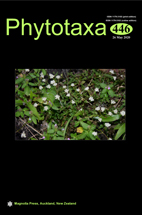Abstract
We describe and illustrate a new nothospecies in the genus Laelia: L. × meavei Cetzal & E.A. Pérez-García. This new taxon is most likely the result of the introgression between Laelia rubescens fo. peduncularis and L. dawsonii fo. dawsonii. The description of L. × meavei is based on cultivated plants coming from a single locality: Sola de Vega, Oaxaca, on Mexico’s Sierra Madre del Sur. One of the putative parents, L. dawsonii fo. dawsonii, is widely cultivated in the region and known in the wild, but current wild populations are small and scattered. In turn, L. rubescens is typically a lowland species, but in this region it is known to grow at higher elevations and these populations are referable to L. rubescens fo. peduncularis. Flowers of Laelia × meavei are similar to those of L. rubescens, but they are larger and longer lasting, whereas the plants look more like a small L. dawsonii fo. dawsonii. Furthermore, to be consistent with the broad circumscription of Laelia followed here, we provide a new combination for the recently described Encarbacenia perezgarciae Archila & Szlachetko. Finally, the following new combination is proposed, L. dawsonii fo. chilapensis (Soto-Arenas) E.A. Pérez-García & Cetzal.

